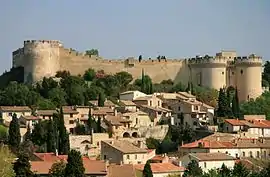Villeneuve-lès-Avignon
Villeneuve-lès-Avignon (French pronunciation: [vil'nœv lez‿avi'ɲɔ̃]; Provençal: Vilanòva d’Avinhon) is a commune in the Gard department in southern France. It can also be spelled Villeneuve-lez-Avignon.
Villeneuve-lès-Avignon | |
|---|---|
 Fort Saint-André on Mont Andaon | |
.svg.png.webp) Coat of arms | |
Location of Villeneuve-lès-Avignon | |
 Villeneuve-lès-Avignon  Villeneuve-lès-Avignon | |
| Coordinates: 43°58′02″N 4°47′48″E | |
| Country | France |
| Region | Occitania |
| Department | Gard |
| Arrondissement | Nîmes |
| Canton | Villeneuve-lès-Avignon |
| Intercommunality | CA Grand Avignon |
| Government | |
| • Mayor (2020–2026) | Pascale Bories[1] |
| Area 1 | 18.27 km2 (7.05 sq mi) |
| Population | 12,848 |
| • Density | 700/km2 (1,800/sq mi) |
| Time zone | UTC+01:00 (CET) |
| • Summer (DST) | UTC+02:00 (CEST) |
| INSEE/Postal code | 30351 /30400 |
| Elevation | 10–181 m (33–594 ft) (avg. 25 m or 82 ft) |
| 1 French Land Register data, which excludes lakes, ponds, glaciers > 1 km2 (0.386 sq mi or 247 acres) and river estuaries. | |
History
In the 6th century the Benedictine abbey of St André was founded on Mount Andaon, and the village which grew up round it took its name.[3] The city itself was founded by Philippe le Bel and boasts a castle he built, Fort Saint-André.
The town was also the resort of the French cardinals during the sojourn of the popes at Avignon, in the 14th century.[3]
Population
|
| ||||||||||||||||||||||||||||||||||||||||||||||||||||||||||||||||||||||||||||||||||||||||||||||||||||||||||||||||||
| Source: EHESS[4] and INSEE (1968-2017)[5] | |||||||||||||||||||||||||||||||||||||||||||||||||||||||||||||||||||||||||||||||||||||||||||||||||||||||||||||||||||
Sights
- Fort Saint-André, on a hill outside the town
- Tour Philippe Le Bel, 14th century
- The church of Notre Dame, dating from the 14th century, contains a rich marble altar and significant pictures.[3]
- Carthusian monastery Notre-Dame-du-Val-de-Bénédiction, founded in 1356 by Pope Innocent VI[3]
International relations
Villeneuve-lès-Avignon is twinned with:
Gallery


 Chartreuse du Val de Bénédiction
Chartreuse du Val de Bénédiction Collapsed apse of church, Chartreuse du Val de Bénédiction
Collapsed apse of church, Chartreuse du Val de Bénédiction Cloister of Saint John, Chartreuse du Val de Bénédiction
Cloister of Saint John, Chartreuse du Val de Bénédiction Chapel of the frescos, Chartreuse du Val de Bénédiction
Chapel of the frescos, Chartreuse du Val de Bénédiction Tomb of Pope Innocent VI, Chartreuse du Val de Bénédiction
Tomb of Pope Innocent VI, Chartreuse du Val de Bénédiction
References
- "Répertoire national des élus: les maires" (in French). data.gouv.fr, Plateforme ouverte des données publiques françaises. 13 September 2022.
- "Populations légales 2020". The National Institute of Statistics and Economic Studies. 29 December 2022.
- One or more of the preceding sentences incorporates text from a publication now in the public domain: Chisholm, Hugh, ed. (1911). "Villeneuve-lès-Avignon". Encyclopædia Britannica. Vol. 28 (11th ed.). Cambridge University Press. p. 85.
- Des villages de Cassini aux communes d'aujourd'hui: Commune data sheet Villeneuve-lès-Avignon, EHESS. (in French)
- Population en historique depuis 1968, INSEE
Further reading
- Fabrié, Marie-Luce (2000). "La collégiale Notre-Dame de Villeneuve-lez-Avignon". Congrès archéologique de France - Monuments du Gard, 157e session 1999 (in French). Paris: Société française d'archéologie. pp. 455–465.
- Labande, M. L.-H. (1910). "Villeneuve-lez-Avignon". Congrès archéologique de France, 76e session, 1909, Avignon. Volume 1 Guide du Congrès (in French). Paris: Picard. pp. 129–130.
- Labande, M. L.-H. (1910). "La Collégiale de Notre-Dame". Congrès archéologique de France, 76e session, 1909, Avignon. Volume 1 Guide du Congrès (in French). Paris: Picard. pp. 141–144.
- Labande, M. L.-H. (1910). "La Chartreuse". Congrès archéologique de France, 76e session, 1909, Avignon. Volume 1 Guide du Congrès (in French). Paris: Picard. pp. 144–158.
This article is issued from Wikipedia. The text is licensed under Creative Commons - Attribution - Sharealike. Additional terms may apply for the media files.